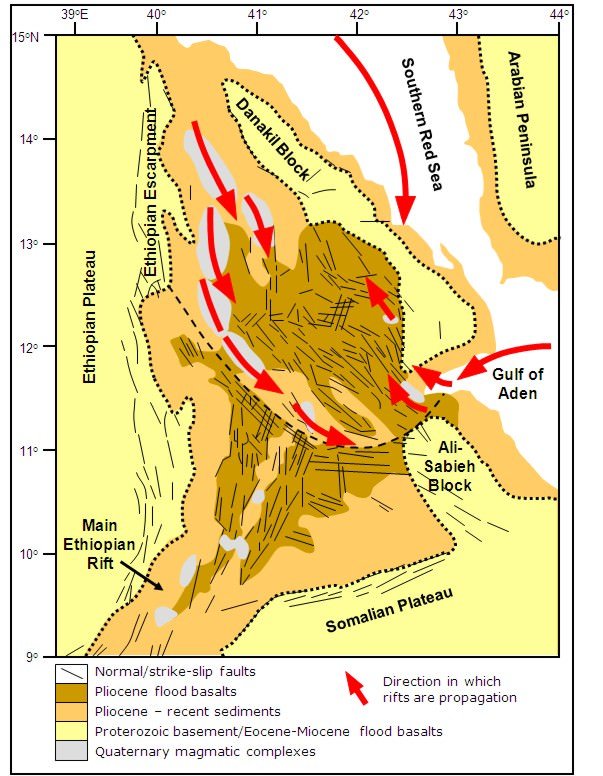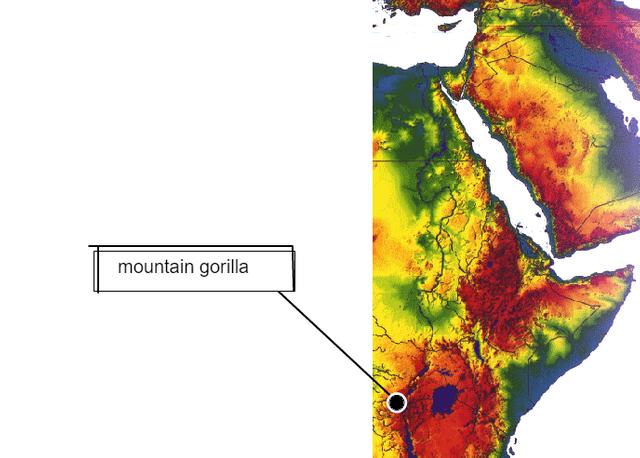The Pthirus gorillae host switch around 3.3 Ma[1] points to that Au. afarensis would have been in contact with ancestors of gorilla. The Danakil-CHLCA (chimpanzee-human-last-common-ancestor) hypothesis posits that geographical isolation, from when the Afar rift opened up and separated Danakil from Ethiopia[2] , would be the cause of speciation of Au. afarensis, and that Au. afarensis adapted to forage from the sea floor, similar to how otters are water-adapted mustelids (Morgan, 1990).
The discovery of Chororapithecus abyssinicus[3] (9 Ma, Chorora formation) in 2007 shows that ancestors of gorilla lived on the southeastern Ethiopian highlands, and would have undergone speciation by adapting to a high-elevation environment as the highlands formed.
Within a scenario where the descendants of Chororapithecus were the origin of the Pthirus gorillae host switch, Au. afarensis would have migrated to the highlands, away from Danakil, for whatever reason. The pliocene flood basalts, a tectonic rift event between 1–4 million years ago, could have provided a land bridge to the mainland, and also made the south-western coastline of Danakil uninhabitable as a result of earth quakes and volcanic eruption.

Increased tectonic activity around 3 million years ago, and a land bridge to the mainland on the south, would be a reason to leave Danakil and seek shelter in the highlands.
The "lack of food" problem, and the Turkana population as those interbreeding with gorillae
The "beach apes" would not be adapted to the highland region, and so may have not been able to find food. Another possibility is that the Au. anamnesis population at lake Turkana, that developed into Kenyanthropus platyops (3.5 - 3.2 Ma) were the ones that made contact with gorillae and that spread Pthirus gorillae to extant humans. Today, mountain gorilla live in the Virunga mountains, and lake Turkana is in between those and the Chorora formation.

Turkana is also where a lot of Paranthropus are found, and Kenyanthropus platyops is occasionally suggested as a direct ancestor to humans, which means they would have been carrying Pthirus pubis.

very interesting,,,,,,,,,,,,
the post is great ...///...///...///
Downvoting a post can decrease pending rewards and make it less visible. Common reasons:
Submit
Nice and interesting every day something new to learn steem on :)
Downvoting a post can decrease pending rewards and make it less visible. Common reasons:
Submit
Here is a visualization of Au. afarensis, from an illustrator I have worked with, as a sort of origin story for Pangea (the web 3.0 jurisdiction, where Steemit is a stepping stone to that)
It shows the coast-line of southern Crete in the background, formed by faulting of the mountain. Create is one of the most tectonically active region in the Mediterranean, and Danakil would have been very much similar (positioned in a triple junction, Afar)
Downvoting a post can decrease pending rewards and make it less visible. Common reasons:
Submit
that's great to know
Downvoting a post can decrease pending rewards and make it less visible. Common reasons:
Submit
so interessing thanks for sharing glad to follow you
Downvoting a post can decrease pending rewards and make it less visible. Common reasons:
Submit
thats really informative 😍 thats why i love steemit 😍 keep posting
Downvoting a post can decrease pending rewards and make it less visible. Common reasons:
Submit